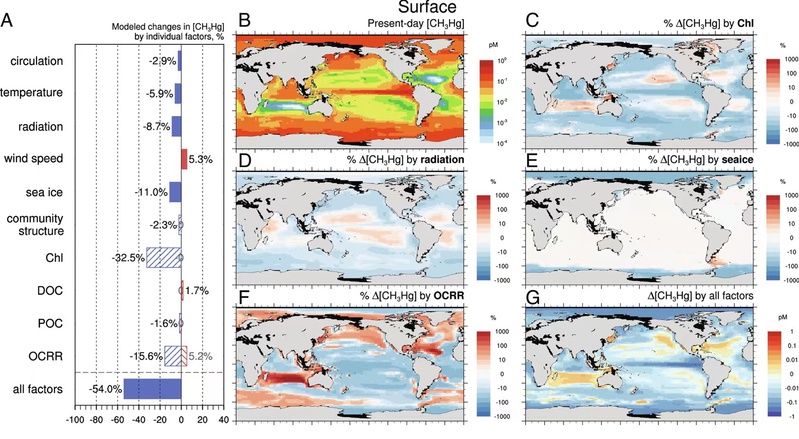Mercury (Hg) is a persistent global pollutant. The ocean, as an important reservoir of mercury, plays a central role in the biogeochemical cycle of Hg: monomethylmercury (CH3Hg), formed through methylation by marine microbes, is an environmental neurotoxin that can be absorbed by planktons and biomagnified through the marine food chain/web. Human exposure to CH3Hgmost commonly occurs through seafood ingestion and raises serious concerns in public health. Since industrialization, the ocean has been continuously affected by anthropogenic climate change: temperature increase, ocean acidification, ecosystem diversityloss…… The transformation and bio-uptake of Hg and its compounds in the marine environment are regulated by marine biogeochemical conditions. Understanding the response of the global marine mercury cycle in the context of climate change is important for determining the future Hg-related health risks and developing regulatory strategies to reduce emissions.
In this study, Professor Yanxu Zhang’s group quantifiedthe impacts of different aspects of global climate change on the global ocean mercury cycle at the end of 21st century under a business-as-usual emission scenario by designing sensitivity analysis experiments and using cross-disciplinary methods and data from 3D marine biogeochemical models, marine ecosystem models, and Earth system models. They identified several important impact pathways in the future oceanic mercury cycle: elevated seawater temperature decreases the solubility of elemental Hg, exacerbating its escape at the air-sea interface. Weakened winds near the sea surface reduces the rate of air-seaexchange. The reduced export of particulate organic carbon reduces the sinking flux of particulate Hg, thus reducing the supply of inorganic Hg in the subsurfaceocean; the reduction in productivity also reduces microbial methylation activities. They also simulated an increase in CH3Hg photodemethylation potential caused by increased incident shortwave radiation and less attenuation by decreased sea ice and chlorophyll.To sum up, this study quantitatively identifies the effects of various physical, chemical, and biological factors of climate change on marine inorganic Hg and CH3Hgconcentrations and their distributions. The resultsoffered insight into the synergisms/antagonismsin the marine Hg cycling among different climate change stressors. The key influencing factors spotted in the study may present a perceptible way of identifying future human exposure to CH3Hg and improving relevant regulatory strategies in the context of global climate change.

Figure 1. Modeled effects of climate change on CH3Hg concentration in the surface ocean.

Figure 2. Schematic representation of the effects of climate change impacts on marine mercurycycling.
This paper entitled“Climate-driven changes of global marine mercury cycles in 2100”was published online in Proceedings of the National Academy of Sciences (PNAS) on January 3, 2023 (doi: 10.1073/pnas.2202488120). ProfessorYanxu Zhang from School of Atmospheric Sciences, Nanjing University is the corresponding author of the paper, and Yujuan Wang, a doctoral student of Class of 2020, is the first author.This study is financially supported by the National Natural Science Foundation of China (42177349), the Fundamental Research Funds for the Central Universities (grant no. 14380188, 14380168), Frontiers Science Center for Critical Earth Material Cycling, and the Collaborative Innovation Center of Climate Change, Jiangsu Province.
The link:https://www.pnas.org/doi/10.1073/pnas.2202488120
